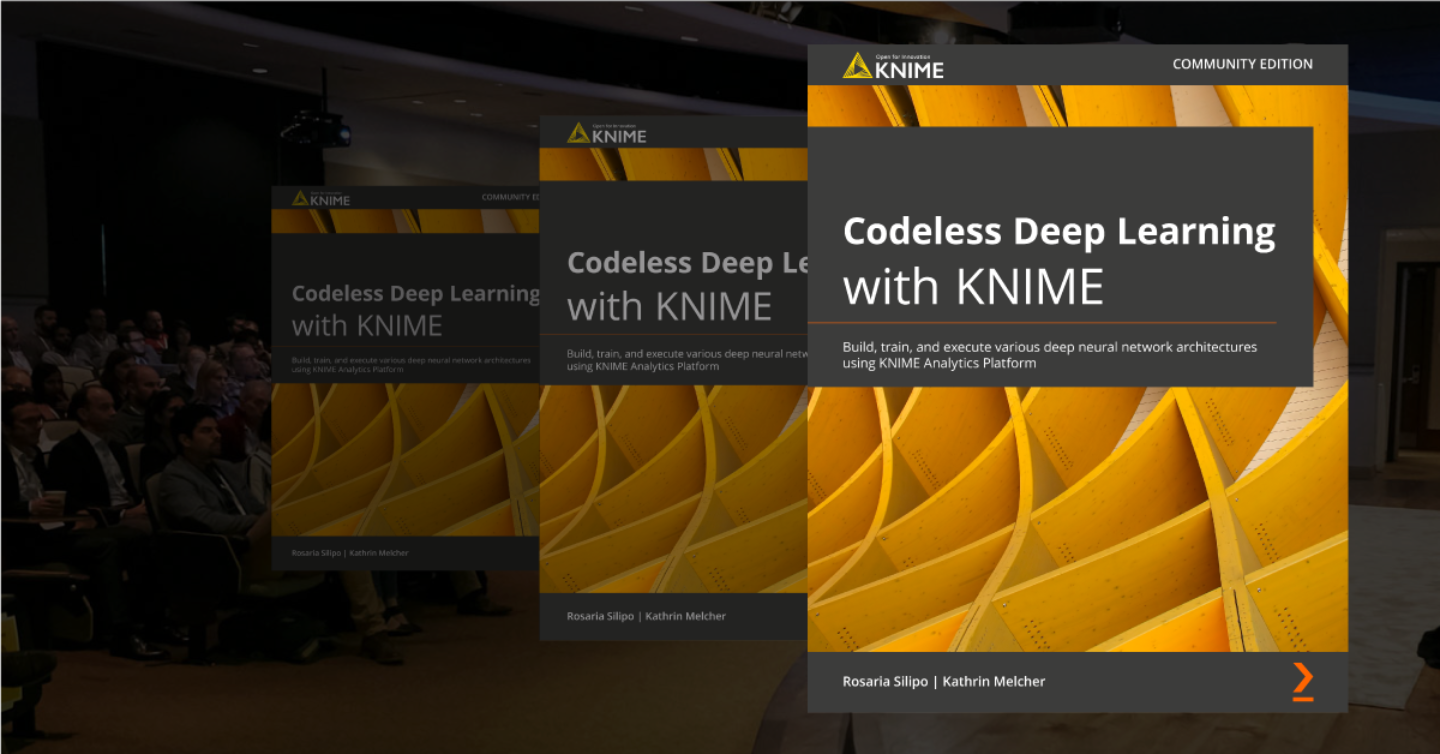A New Book by Packt Publishing
A few days ago, at the KNIME Fall Summit, I announced the new book “Codeless Deep learning with KNIME”, which I co-authored with my colleague Kathrin Melcher and is soon to be published by Packt Publishing.
Now, in the post Fall Summit relaxation, and talking to myself in these times of COVID-induced isolation, I was wondering why we invested all this time writing this book and why people should read it. I will report here this short conversation I had with myself.
Q: Do we really need one more book about deep learning?
A: Indeed, there are plenty of books about deep learning: textbooks for academic courses, theory books to investigate the underlying math, Python books to show step by step, code based implementations, and surely many more flavors of similar books. Well now, this book is slightly different. It is not a textbook and the math is limited to necessary formulas to understand the described implementations. It is also not a Python book or a coding book. It is a practical book, which, case study after case study, teaches you specific solutions to specific tasks, gives you the theory for the required deep learning algorithms, their codeless GUI based implementations, and some best practices elaborated from our own experience. It uses the open source, codeless visual programming based software: KNIME Analytics Platform. It must have been worth the time invested in writing it, because I do not know of any book like this on the market.
Q: How was the book born?
A: If you have followed our professional activities recently, you know that we - and especially Kathrin - have been working intensely on solutions based on deep learning. From an autoencoder based fraud detector to a rap song generator, from a neural machine translator to a classifier of cancer cell images, we have tried a large number of neural architectures, tested many encoding strategies, optimized a number of parameters, deployed networks with and without scalability constraints, studied strategies to avoid overfitting, investigated the optimal length of input sequences, and much more all in the past two years. All this experience … we could not let it go to waste! Therefore, we decided to package it in a clear, practical book that will enable more people to benefit from all this knowledge about codeless implementations of deep learning solutions. You will see that each case study requires a different solution with a different set of optimal parameters, depending on the required task and the available data. We hope we have revealed all the details and all the secret sauces clearly in each chapter of the book.
Q: What can I find inside the book?
A: The book is organized by case studies: one chapter is on image processing and cancer cell classification; another chapter on LSTM units and free text generation; another chapter on neural machine translation; and so on. In each case study you will learn about the task at hand, about the specific deep learning architecture used for the solution, what is required to appropriately prepare the data, plus a few guidelines for best practices. Since the proposed task is different, you will have something new to learn in each chapter.
The book also introduces you to some basic and advanced features of KNIME Analytics Platform and the KNIME Deep Learning Keras Integration. The first chapters also lay out the basic math concepts to understand the neural architectures, their training, and their application.
Finally, it concludes with tips about deployment and the best practices to avoid common mistakes in the training and application of deep learning networks.
Q: Who are the authors
A: The authors of the book are Kathrin Melcher and myself. Currently, we both work in the evangelism group of KNIME. Our job is mainly to explore new data science solutions and machine learning algorithms, pre-digest them, and then spread the knowledge around.
Kathrin is a math graduate from the University of Konstanz. She has a strong interest in data science, machine learning algorithms, and enjoys teaching and sharing the knowledge about all that. That is why in the evangelism group she heads education, teaching courses from data wrangling to machine learning algorithms. When she is not teaching, she spends her working time assembling creative solutions for data science problems.
I, in comparison, have been in the field for more than 25 years, when neural networks were also popular. I graduated in 1992 with a thesis on the usage of neural networks to classify events in biomedical signals. I continued this work in my doctorate program, still mostly employing neural networks. After that, I have been alternating jobs in programming and data science - in various fields, such as speech recognition, financial transactions, IoT, customer intelligence. Ultimately, I have stuck with data science here at KNIME, where I now head the evangelism group.
In the last two years, I and especially Kathrin have taken on some data science projects, that we have then solved using some deep learning techniques. This book is the result of the work and experience from these past two years.
Q: Final question: Was it fun?
A: I can only speak for myself here. I quite enjoyed writing this book. Most of the material was already clear in our heads and we “just” had to write it down in a clear form. Also, the proposed format, i.e. through a sequence of case studies, fits our forma mentis perfectly. Indeed, what we do every day at work is to create solutions for data science problems and then explain them within the frame of a case study. I found the experience formative and rewarding, especially when, after typing the last word in the manuscript, we were able to literally see all the work we had accomplished in the past months.
I hope you are going to have a similarly enjoyable experience reading each chapter!
